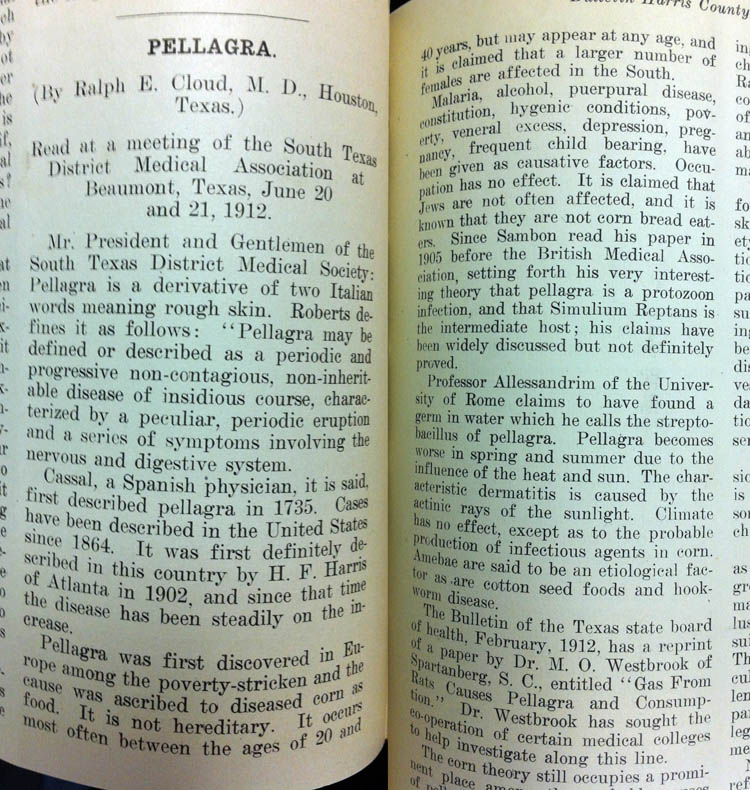by Alethea Drexler, archives assistant
Today’s post combines history, medicine, and food.
We’ll start with the Harris County Medical Society Bulletin, Volume 3, Number 4, August 1912[1], and an excerpt about pellagra (this image has been photoshopped so that it would fit in one space. These are from pages 12 and 13):
Nineteen-twelve was a long time ago, but not out of reach. All of my grandparents were born within a few years of 1912; there aren’t many people around who are old enough to remember 1912 but there are plenty of people around who knew somebody who was.
The disease in question is pellagra. Pellagra is a disfiguring and disabling disease[2] that was relatively common in the American South well into the twentieth century. It’s clear from the article above that the Medical Society (along with the rest of the world) didn’t yet know what caused it. Theories had been bandied about for centuries.
Public health official Joseph Goldberger, M.D.[3], would confirm the corn-diet theory through a series of experiments on patients at the Spartanburg [South Carolina] Pellagra Hospital and on a set of prisoners, between 1914 and 1926[4]. The root cause–lack or inaccessibility of the B-vitamin niacin in the diet–was finally discovered by Conrad Elvehjem[5] in 1937. (That there was at least one entire hospital devoted to study and treatment of pellagra suggests how widespread a problem it was.)
It would turn out that Gaspar Casal[6], the eighteenth-century Spanish physician who first described the disease’s dermatological symptoms and blamed it in part on a corn-based diet, noted in the article above, had it at least kind of right. Specifically, the problem was a diet based on unprocessed corn. Native American populations that had relied on corn for centuries developed a method of processing grain known now by the Nahuatl-derived[9] term nixtamalization[10]. Nixtamalization uses an alkaline solution to break down the grain’s cell walls, making the corn’s niacin[8] content available for absorption when eaten, sparing them from pellagra. Nixtamalization creates what we would recognize as hominy or masa (masa is the basis for the tender corn mush used in tamales. You’ll recognize the root word “tamal”). Populations that relied on a diet of plain corn-meal that had not been processed were at risk of vitamin deficiency because their bodies couldn’t access the vitamin in the grain[4].
This webpage[13] is not academic but it does have a picture of the Spartanburg Pellagra Hospital.
Works consulted:
1] Harris County Medical Society Bulletin, V.03 N.04, August 1912, pages 12, 13.
2] MedlinePlus: Pellagra
3] National Institute of Health: Joseph Goldberger
4] Wikipedia: Pellagra
5] Wikipedia: Conrad Elvehjem
6] Wikipedia: Gaspar Casal
7] La Fundación Gaspar Casal
8] PBS.org, “A Science Odyssey: Joseph Goldberger“
9] Omniglot: Nahuatl
10] Wikipedia: Nixtamalization
11] MedlinePlus: Niacin
12] University of Alabama: Pellagra in Alabama
13] Slobot About Town: Pellagra
14] National Academy of Sciences: Conrad Arnold Elvehjem (1901-1962)
